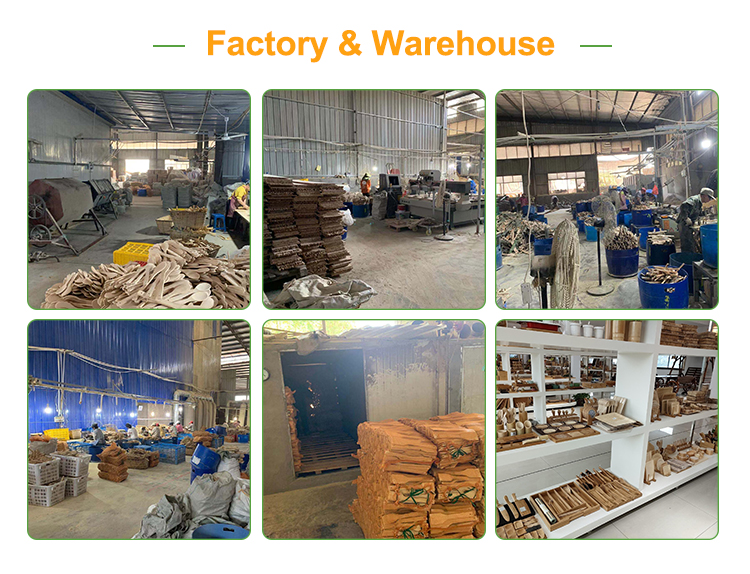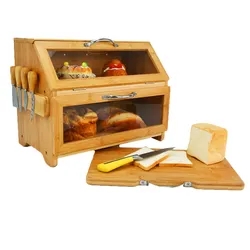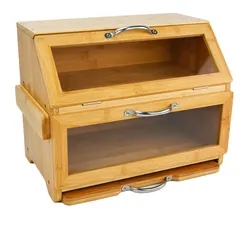Using bamboo in the kitchen can offer several benefits. Here are some of the advantages of using bamboo kitchenware:
- Sustainability: Bamboo is a highly renewable resource. It grows quickly and requires minimal water and no pesticides or fertilizers to thrive. Harvesting bamboo does not result in deforestation as the plants regenerate from their roots, making it an eco-friendly choice for kitchen products.
- Durability: Bamboo is known for its strength and durability. Bamboo kitchenware, such as cutting boards, utensils, and bowls, can withstand regular use and are less prone to cracking or warping compared to other materials.
- Natural Antibacterial Properties: Bamboo contains a natural antimicrobial agent called “bamboo kun” which helps inhibit the growth of bacteria. This makes bamboo kitchenware hygienic and reduces the risk of cross-contamination while preparing food.
- Non-Absorbent: Bamboo is less porous than wood, which means it is less likely to absorb liquids and odors from food. This property makes it easier to clean and maintain bamboo kitchenware.
- Lightweight and Easy to Handle: Bamboo kitchen utensils are lightweight and comfortable to use. They are ideal for stirring, flipping, and serving food without straining your wrists or arms.
- Heat and Stain Resistance: Bamboo has natural heat resistance, which makes it suitable for hot pots, pans, and serving dishes. It is also less likely to stain compared to porous materials like wood.
- Aesthetically Pleasing: Bamboo kitchenware adds a natural and organic touch to your kitchen. The light color and unique grain patterns of bamboo can enhance the visual appeal of your cooking space.
- Versatility: Bamboo can be crafted into various kitchen items, including cutting boards, utensils, bowls, trays, and even flooring. Its versatility allows you to choose from a wide range of bamboo products to suit your needs and style preferences.
When purchasing bamboo kitchenware, ensure that it is sourced from sustainable and responsibly managed bamboo forests. Look for products that are free from harmful chemicals and are certified as food-safe. Proper care and maintenance, such as regular oiling and handwashing, can help prolong the lifespan of your bamboo kitchenware.
When it comes to packaging bamboo kitchenware, there are several methods that can be used to ensure its safe transportation and storage. Here are some common packaging methods for bamboo kitchen products:
- Cardboard Boxes: Bamboo kitchenware is often packaged in cardboard boxes. The items are placed inside the box, surrounded by protective materials such as bubble wrap, paper, or foam inserts to prevent any movement or damage during transit. The boxes are then sealed with adhesive tape.
- Plastic Wrap or Bags: Some bamboo kitchenware, especially smaller items like utensils or bamboo straws, may be individually wrapped in plastic bags or shrink-wrap to protect them from scratches or dirt. These wrapped items are then placed in larger cardboard boxes for bulk packaging.
- Biodegradable or Eco-Friendly Packaging: With the increasing focus on sustainability, there is a growing trend to use eco-friendly packaging materials for bamboo kitchen products. This can include biodegradable or compostable packaging materials made from plant-based sources, such as cornstarch-based packing peanuts or biodegradable bubble wrap alternatives.
- Display Packaging: In retail settings, bamboo kitchenware can be packaged in display boxes or packaging that showcases the product while keeping it protected. These packaging designs often feature a transparent window or open-front design to allow customers to see the item inside.
- Custom Packaging: Some bamboo kitchenware brands may opt for custom packaging solutions to enhance their brand identity and provide a unique unboxing experience. This can include custom-designed boxes, sleeves, or labels that reflect the brand’s aesthetic and values.
It’s worth noting that the specific packaging method may vary depending on the type of bamboo kitchenware, its size, and the preferences of the manufacturer or brand. Additionally, as sustainability becomes more important, efforts are being made to reduce packaging waste and utilize more environmentally friendly materials in the packaging process.
Using bamboo in the kitchen can offer several advantages. Here are some of the benefits of using bamboo kitchenware:
- Sustainability: Bamboo is a highly renewable and sustainable resource. It grows quickly, reaching maturity in just a few years, and does not require replanting after harvesting. It also does not contribute to deforestation as it can be harvested without killing the plant, as it regenerates from its root system.
- Durability: Bamboo kitchenware is known for its strength and durability. It is harder than many hardwoods and can withstand regular use without cracking or warping. This makes bamboo products long-lasting and cost-effective.
- Lightweight: Bamboo kitchenware is lightweight compared to materials like metal or ceramic. This makes it easy to handle and maneuver while cooking or serving food.
- Natural Antimicrobial Properties: Bamboo has natural antimicrobial properties that help inhibit the growth of bacteria and fungi. This makes bamboo kitchenware more hygienic and reduces the risk of cross-contamination during food preparation.
- Non-Absorbent: Bamboo is naturally non-porous, which means it does not absorb liquids or odors from food. This property makes it easier to clean and maintain. It also helps prevent the growth of bacteria and keeps the kitchenware odor-free.
- Heat Resistance: Bamboo has natural heat resistance, making it suitable for use in the kitchen. Bamboo cutting boards, utensils, and trivets can withstand high temperatures without warping or cracking.
- Versatility: Bamboo can be crafted into various kitchenware items such as cutting boards, utensils, bowls, trays, and more. Its versatility allows for a wide range of products to suit different cooking and serving needs.
- Aesthetic Appeal: Bamboo kitchenware has a natural and organic look that can add an aesthetic touch to your kitchen. The light color and unique grain patterns of bamboo can complement various kitchen designs and styles.
- Eco-Friendly: Choosing bamboo kitchenware supports eco-friendly practices. Bamboo is a sustainable and renewable resource that helps reduce the reliance on traditional wood or plastic materials. By opting for bamboo, you contribute to environmental conservation efforts.
It’s important to note that the quality and durability of bamboo kitchenware can vary depending on the manufacturing process and the specific product. Look for high-quality bamboo kitchenware from reputable brands to ensure long-lasting and safe use in your kitchen.















